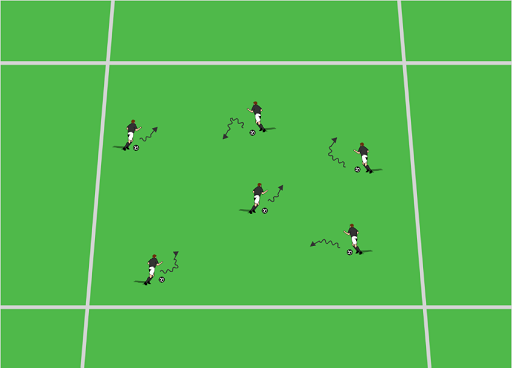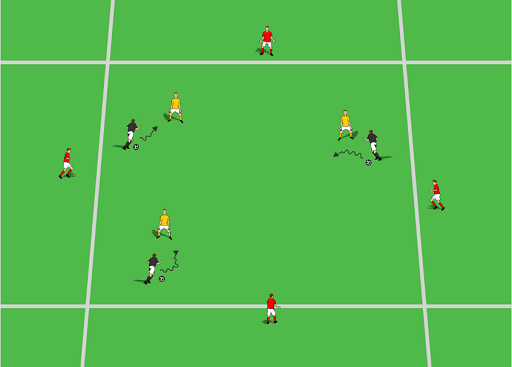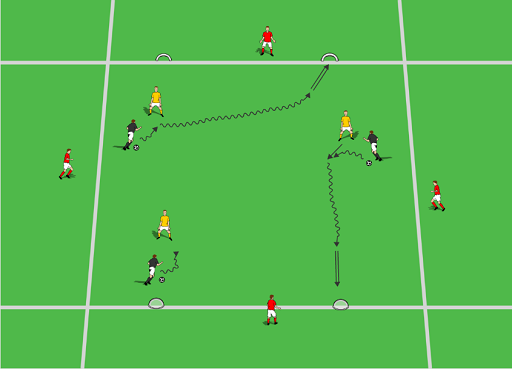By Gregg Gillies -
Warm Up: Grid Dribbling
Set Up: Size (30 yds x 25 yds) Field size can vary depending on the number of players you have. You only need four cones but can add a few more if this helps keep the players in the playing area.
The Rules:
- Each player has a ball and must stay within the grid
- They dribble the ball at top speed, while keeping the ball under control, avoiding collisions with other players, and continually changing direction with their dribble
- Players work at maximum effort for 15 seconds and then perform a recovery dribble, slowly dribbling within the grid for 30 seconds
- After each round give the players 30 to 60 seconds (or more, if needed. The less rest, the more conditioning involved, the more rest, the more technical oriented the drill) of total rest.
- Have the players perform 4 to 10 total rounds.

For the first round or two, allow the players to change direction any way they like.
After that, perform a few rounds with any of the following moves.
- Simple Outside of the Foot touch
- Lunge fake – when approaching the defender step out hard to one side as if you are about to accelerate around the defender in that direction but do not touch the ball. Then, using the outside of the opposite foot, take a touch the other direction around the defender.
- Scissors
- Double Scissors
- Step Over
- Matthews
- Matthews with Scissors
- Fake Kick and Go (fake a kick to the left with the right foot, place the right foot on top of the ball, take a slight backward hop on the left foot, and then accelerate away to the right by touching the ball with the outside of the right foot). You can also do the opposite.
- 180 Pull Back
- Cruyff
- 180 Chop Cut (inside and outside of the foot chops)
You would not use all of these every time you do this drill. Pick three or four and focus on them in one session.
How many moves or the difficulty of the move is left up to you, the coach. You know your players skill level the best. Obviously you won't be using the Matthews with Scissors, or the Maradona with 4 year olds.
Coaching Points:
The focus is good control, with quick, soft touches at speed, as well as rapid change of direction.
Players should have slightly bent knees when they change direction and should be keeping the ball close, so that they are balanced and under control, ready to go in any direction. They should not be reaching out with one leg, extending it too far away from them to make a cut and change direction.
Technique (Footwork) - Players must be able to dribble with both feet, while making short, sharp touches on the ball. The ball can not be allowed to get away from them or they will lose control.
Technique (Vision) – Does the player have the ability to get their head up and see what's around them? If they don't, they will constantly run into other players, or get run into by other players.
Positive Attitude and Confidence – It's very important to be supportive of your players and encourage them when it comes to their dribbling. Most players take way too big a touch and always want to use speed to basically pass to themselves (especially at younger ages) and use their speed. It's important that they become confident with the ball at their feet. It doesn't matter how good they become at one touch passing, if they can't have the ball at their feet, they will not be successful at the game of soccer.
Progressions and Variations:
Every player dribbles on their own, constantly changing direction. The coach yells out a move and the player must perform that move as soon as possible.
Another variation is to have the players dribble for 30 seconds, performing as many moves as possible in that timeframe. Give the players three to four moves to focus on. They can perform the same move multiple times but not in a row. So the could do a scissor, then a cruyff and then do a scissor again.
This adds a bit of a competitive element into a non-competitive drill. The players will work harder and enjoy it more.
Exercise: Multi 1v1 With Extra Defenders
Set Up: Size (30 yds x 25 yds) Field size can vary depending on the number of players you have. You only need four cones but can add a few more if this helps keep the players in the playing area.
The Rules:
- Depending on your numbers and skill level, have 6 to 10 players in the middle. The players are divided into groups of two, with each group having one ball.
- The remaining players are outside of the grid and are defenders. They stay on the imaginary sideline line but patrol up and down that line.
- The pairs play 1v1 in the grid. This means their are multiple 1v1 games going on at the same time. The object for the player with the ball is to “score” by dribbling across any of the four sidelines and stoping the ball under control. The “defenders” on that sideline can knock the ball away, being careful not to venture onto the field of play.
- Games last 30 to 60 seconds. When a game is finished send the 1v1 players to the outside to become defenders and the defenders enter the grid and are matched up into pairs to play 1v1.
- After each round give the players 30 to 60 seconds (or more, if needed. The less rest, the more conditioning involved, the more rest, the more technical oriented the drill) of total rest.

Coaching Points: – same as above.
This one is especially important.
Positive Attitude and Confidence – It's very important to be supportive of your players and encourage them when it comes to their dribbling. Most players take way too big a touch and always want to use speed to basically pass to themselves (especially at younger ages) and use their speed. It's important that they become confident with the ball at their feet. It doesn't matter how good they become at one touch passing, if they can't have the ball at their feet, they will not be successful at the game of soccer.
Progressions and Variations:
Depending on age and skill level you may make this a rule or just encourage it. It's important to encourage players to try moves when attacking 1v1, not just using a simple touch to the side and trying to dribble past a defender. Encourage and support your players to be creative and make mistakes. That's how they get better, build confidence and eventually use these moves in games.
Exercise: Multi 1v1 With 4 Goals
Set Up: Size (30 yds x 25 yds) Field size can vary depending on the number of players you have. You only need four cones but can add a few more if this helps keep the players in the playing area.
The Rules:
- Depending on your numbers and skill level, have 6 to 10 players in the middle. The players are divided into groups of two, with each group having one ball.
- The remaining players are outside of the grid and are “walls”. They are there to keep the ball in play by stopping it and letting the 1v1 continue.
- The pairs play 1v1 in the grid. This means their are multiple 1v1 games going on at the same time. The object for the player with the ball is to score in one of the two small goals in the direction in which they are going. This drill is direction specific, just like a full sized game.
- Games last 30 to 60 seconds. When a game is finished send the 1v1 players to the outside to become the “wall” and the “wall” players enter the grid and are matched up into pairs to play 1v1.

Coaching Points and Progressions and Variations are the same as above.
One added variation would be to make the outside players neutrals, giving the 1v1 offensive player someone to pass to, so they can add off the ball movement to the drill. You can increase the difficulty level by giving the outside players one touch.
By Gregg Gillies
Gregg Gillies is a nationally licensed coach through the USSF and is a Youth Athlete Development Specialist and Head Coach at Mount Laurel United Soccer Club, where he currently coaches a u14 girls team, the MLU Raptors. He also is the owner of www.NoLimitsSoccerTraining.com, where his focus is on maximizing a player's individual technical skills, soccer IQ, and overall athletic development.


